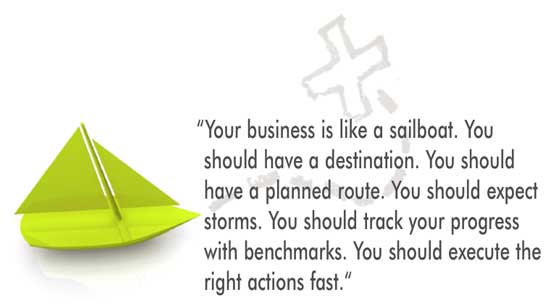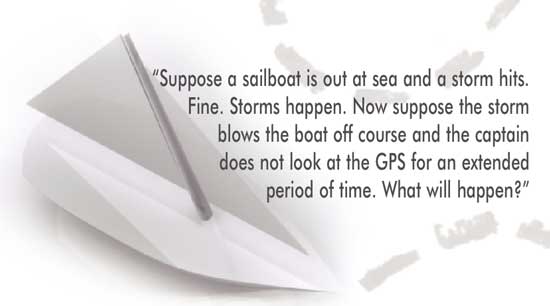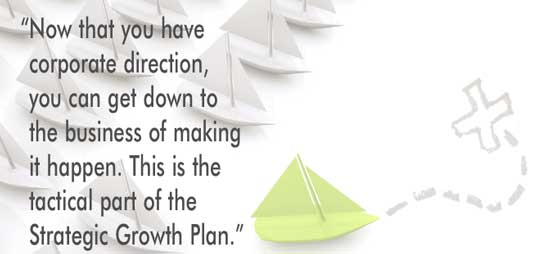W hen asked, “Would you like to grow your business?” 100% of furniture retailers say, “Yes.”
And most respond positively to the inquiry, “Do you think that having a plan for that growth is important?”

But to the queries, “Do you have a general, long-term 3-year strategic plan in place?” and “Do you have a detailed annual plan with benchmarks that you use to measure performance monthly?” Only a few say, “Yes.”
YOUR GROWTH PLAN
Consider this: A Strategic Growth Plan is to your company what a GPS is to a sailboat out at sea.
The destination, approximate time, and course are known. The conditions of travel are unpredictable, but the possibilities are understood. During a sailboat’s voyage, a host of obstacles and opportunities are encountered. Some push the boat off course. However, the destination does not change. The GPS just recalibrates and the route and actions are redirected. Inevitably, the captain and crew work efficiently together. Then, they arrive.
For your business, strategic growth planning is an essential tool to turn your goals into reality. It is the GPS for your future. It helps your business stay on course. When inevitable challenges arise, the strategic plan helps you reroute your tactics. It improves team focus and enables you to reach targets as fast and efficiently as possible.
Without this tool in place, your business risk is much higher. This is due to counting more on “dumb-luck” than on strategy. Also, those businesses that don’t plan tend to be reactive with decision making rather than proactive. Their managers tend to be short-term focused, looking only a week or month ahead. They are obsessed with past performance rather than future performance. It is true that non-strategic business operators are often some of the hardest working managers. Yet, they are not the smartest working managers. It is not surprising that those businesses that strategize properly, define their tactics, and measure their results perform better and are generally less chaotic places to work.
To illustrate the general process of Strategic Growth Planning, it’s useful to ask four questions: Where are you now? How did you get here? Where do you want to be in three years? Is it feasible? Where are you now?
Answering this question is step one. Knowing your exact financial position is a fundamental business analysis. It is impossible to plan a route unless you know from where you are starting. Here are some measurements that can be used to determine where a business is at any point in time:
- Liquidity – cash in comparison with short term obligations.
- Activity – day to day operation efficiency in such areas as sales, inventory, deposits, AR.
- Solvency - long term debt obligations.
- Profitability – costs, margins, and income.
- Value – equity and wealth.
- Break-even sales volume.
- Management ability.
- Team effectiveness.
Knowing this information gives you an accurate measure of your current strength, and will let you know if you have adequate current resources available to fund growth. As well, it shows whether your business is adding to cash reserves and whether debt levels are sustainable. Furthermore, your sales volume required to achieve desired profits and cash flow can be figured from the break even analysis.

Whatever the situation a business is in, it is better to KNOW IT, than be ignorant of it. In fact, as an analyst, I do not care whether the current state is good, bad, or ugly. It’s better to know the true situation – so you can form a Strategic Growth Plan and start to improve the business situation.
HOW DID YOUR FURNITURE STORE GET THERE?
The purpose of this second question is to figure the underlying reasons your business is where it is now. A common way to do this is to look at the past year (or several years) and compare them to current results. From there, percentage growth can be figured using the above mentioned measurements. Correlations can be drawn. For example, if sales grew by 10% and inventory grew by only 5%; that may be an indication of more efficient asset usage. Or, say, sales grew by 10%, advertising grew by 15%, and customer traffic grew by 7%; that may indicate a decline in advertising effectiveness.
Asking this question also stimulates a discussion about the strategic planning process. Your executive team stops guessing as to why things are the way they are. Knowing what worked and what didn’t work and how you arrived at your current destination, sets the stage for the next question.
WHERE DO YOU WANT TO BE IN THREE YEARS?
Have fun with this part. This is higher level stuff. Try to pull yourself out of day to day business operations. You know where you are and have a good idea of how you got there by the time you start this brainstorming. There are really no right or wrong answers here. Some businesses are more aggressive and like to take greater risks to achieve bigger rewards. Others are conservative and wish to grow slower and just accumulate cash at a steady-rate.
When working on growth planning with clients, I like to take a profit-up (or sometimes, cash-up) approach. This means working backwards from yearly goals. Let’s say you want to produce a net income increase of a certain amount. From there, you can determine what sales volume you need to make that happen. This is all done by calculating a cost, volume profit analysis (also called break-even sales). Then by using “What-If?” scenarios, see what would happen to the results if certain things occurred in the future.
With long-term strategy, be realistic, but don’t be afraid to dream, realistically. You are the captain of your business destiny.
IS THAT FEASABLE?
This question tests the 3-year plan. By putting numbers to words, the growth strategy’s feasibility is checked. While doing so, the specific tactics are determined. The management team can then decide whether the long term plan is doable or whether it needs to be modified.
For example, suppose a business wishes to add additional locations. The cost of the expansion is estimated. The projected sales volume, operating profit, inventory levels are just a few things that the business needs to consider when determining the amount of funding and payback that would be necessary to accomplish the goal. If the sales volume increase was deemed too unlikely to support the expansion, then modifications to the three year plan may be necessary. However, if the general actions outlined to achieve the revenue needed, test doable, then, the plan can go forward.
Feasibility testing is done through forecasting methods and dialogue. I suggest using an advanced business profitability/analyst professional such as a CMA or CFA (Certified Management Accountant or Chartered Financial Analyst). He or she can help you create the quantitative plan. In doing so, you can set benchmarks that will guide you to your final destination. Like a seasoned sailboat captain, a specialist in forward business guidance can show you the best route to achieve desired results. I don’t advise sailing alone in uncertain waters. Once you have your feasible 3-Year Growth Plan documented, you can start to think in the short term and ask: What short-term actions are necessary?

Now that you have corporate direction, you can get down to the business of making it happen. This is the tactical part of the Strategic Growth Plan. The short term is one year. Specifically, what does your organization need to do over the next 12 months? This is documented via a detailed budget. Here are some of the monthly targets that should be stated and factors that should be included:
- Sales: sales to plan, average sale, conversion rate, number of guests, sales/guest ratio.
- Gross margin: cost of goods, freight, and pricing strategy.
- General administration costs: Number of employees, salaries, benefits, and overhead.
- Occupancy costs: building maintenance, rents, and utilities.
- Marketing/advertising: media spend / type, marketing calendar, cost per customer and lead.
- Selling costs: number of salespeople and support, commissions, and pay for performance plans.
- Distribution costs: warehousing, shipping, delivery, and distribution income.
- Finance costs: cost of money – financing, interest, bank and credit fees.
- Inventory: percent of sales, margin dollar return, and purchasing.
- Assets: fixed asset requirements.
- Liabilities: debt requirements and payback plans.
- Equity: dollars invested or withdrawn from the business.
- Tax planning: credits, deductions, and quarterly estimations.
Now, what do you think is missing from the list above? It’s cash.
In fact, the one ALL important item that is missing from the short term plan is the net result of the plan. Cash is what is left over. Setting target levels and actions to achieve the above factors will determine cash results.
How do you measure progress and what do you do if you miss your targets?
This is where many businesses lose their way and get off course. They either wait too long or don’t look closely enough at their results versus their annual plan. I will use the sailboat analogy again:
Suppose a sailboat is out at sea and a storm hits. Fine. Storms happen. Now suppose that the storm blows the boat off course and the captain does not look at the GPS for an extended period of time. What will happen?
The ship would be much farther off from its destination. Had the captain or crew paid closer attention to where they were during and after the storm they would have been in a much better position to adjust the course sooner. They might have been able to change their tactics enough to make up the difference.
Sometimes in business the captain and team “are too busy” to measure themselves against the plan. This is a huge and costly error. This is costly because the business becomes less likely to achieve its goals. And missing goal equals missing money. This translates into a less likely chance of executing the growth strategy.
Now, let’s use a different analogy of when a sailboat or business gets hit by a storm:
As the winds are blowing, the captain asks his crew, “Where are we now? What can we do to get out of this?”
When things settle down and the storm subsides, the crew checks where they are again.
The captain asks, “How far are we off course? What actions do we take, NOW, to get to our destination in time?”
Your business is like a sailboat. You should have a destination. You should have a planned route. You should expect storms. You should track your progress with benchmarks. You should execute the right actions fast.
And, you should succeed in growing if you do this.